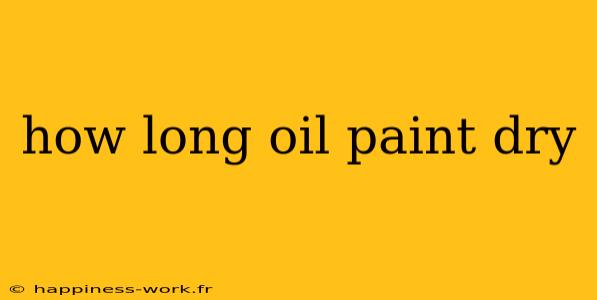Understanding the drying time of oil paint is essential for artists, both novices and professionals alike. It impacts layering, techniques, and overall artwork management. In this article, we’ll explore the drying time of oil paint, factors that influence it, and tips to optimize your painting process.
What is Oil Paint and How Does It Dry?
Oil paint is a type of paint that consists of pigments suspended in drying oils, usually linseed oil. The drying process occurs through oxidation and polymerization, which is the reaction between the oil and oxygen in the air, transforming the paint from a wet, workable state to a hard, durable finish.
How Long Does Oil Paint Take to Dry?
The drying time of oil paint can vary significantly based on several factors, including:
-
Thickness of Application: Thicker applications take longer to dry compared to thin layers. For instance, an oil paint layer that is applied heavily can take several days to weeks to fully dry.
-
Type of Oil Used: Different oils have different drying times. Linseed oil, for example, dries relatively quickly, while poppy oil takes longer.
-
Environmental Conditions: Humidity, temperature, and airflow can greatly influence drying times. For example, warm, dry conditions facilitate quicker drying, while cold and humid environments slow it down.
-
Additives: Certain mediums and additives can be used to alter drying times. For instance, using a fast-drying medium can help speed up the process.
Typical Drying Times
- Touch Dry: Typically, oil paints may become "touch dry" within 6 to 8 hours.
- Handle Dry: The paint may be safe to handle within 24 hours.
- Fully Cured: However, full curing can take anywhere from 6 months to a year depending on the above factors.
Key Tips to Manage Drying Times
-
Work in Thin Layers: Apply your paint in thin layers to facilitate quicker drying. This approach also allows for better control over blending and techniques.
-
Use Fast-Drying Mediums: Consider incorporating mediums designed to speed up drying times, such as alkyd mediums.
-
Optimize Your Environment: If possible, work in a warm, low-humidity area with good air circulation to accelerate the drying process.
-
Patience is Key: Be prepared to wait! Rushing to add layers can lead to muddy colors and a compromised finish.
Why Drying Times Matter
Understanding drying times is crucial for various reasons:
-
Layering Techniques: Artists often use glazing techniques that require the underlayer to be dry before applying additional layers. Knowing how long you need to wait can greatly impact your painting strategy.
-
Storage and Transportation: If you plan to transport your artwork, knowing when it is safe to handle is essential to avoid smudging or damaging your work.
-
Long-term Effects: Proper drying ensures that the paint adheres correctly, preventing cracking and other issues that arise from improper drying.
Conclusion
Understanding how long oil paint takes to dry is not merely a matter of patience; it is essential for any artist looking to create stunning works. By considering factors such as thickness, oil type, environmental conditions, and additives, artists can better manage their workflow and optimize their painting practices.
For those seeking further insight, check out WikiHow for more detailed guides on oil painting techniques and tips.
Attribution: This article includes insights inspired by original content from WikiHow authors, adapted and expanded upon to provide further understanding and practical applications for oil painting enthusiasts.
Happy painting, and remember, the beauty of oil paint is worth the wait!
This article is SEO-optimized for keywords such as "oil paint drying time," "oil painting techniques," and "managing oil paint," helping it reach the right audience effectively.
